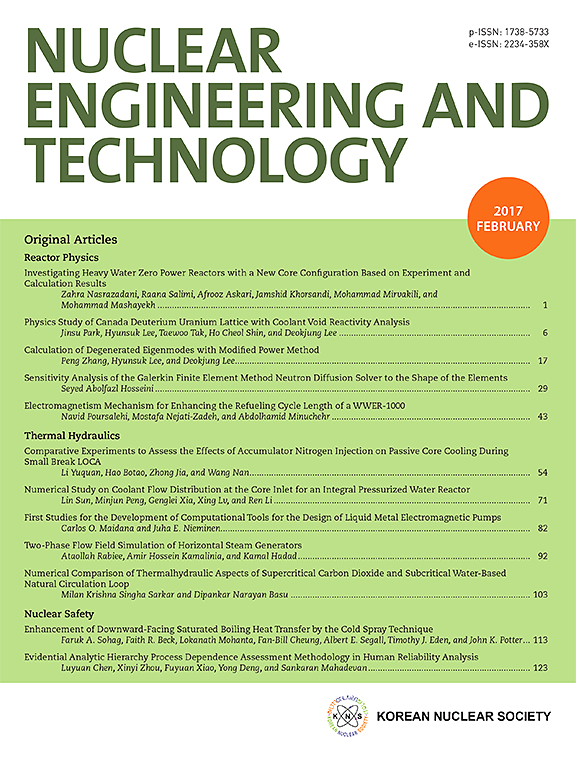Development of a time-of-flight spectrometer for characterizing the quasi-monoenergetic neutron beam driven by a 30-MeV proton cyclotron
IF 2.6
3区 工程技术
Q1 NUCLEAR SCIENCE & TECHNOLOGY
引用次数: 0
Abstract
By developing a time-of-flight (TOF) spectrometer, this study experimentally examines the spectrum of a quasi-monoenergetic neutron (QMN) source generated by irradiating 30-MeV protons from a cyclotron onto a beryllium target. The repetitive irradiation of proton bunches on the target at a radio frequency results in periodic distributions of coincidence events between gamma-ray- and neutron-related signals, necessitating a specific method to extract the neutron spectrum from the TOF measurements. An effective time window of 13.67 ns in the TOF spectrum, corresponding to the period between proton bunches, was identified for analyzing neutrons with energies ranging from 16.19 to 30 MeV. The retrieved neutron spectrum distinctly exhibits a peak at 26 MeV, verifying the spectrum simulated by a Monte Carlo model and supporting the QMN beam’s use in downstream applications. Additionally, a fast-timing scintillator module and its associated algorithm were developed to measure the proton bunch duration on a sub-nanosecond scale, enabling the estimation of the energy resolution in the spectrum, approximately 8% at 30 MeV. These techniques, developed for characterizing the neutron spectrum and proton bunch duration, significantly enhance the quality assurance processes for operating a proton-cyclotron-based neutron source.
30兆电子伏特质子回旋加速器驱动的准单能中子束飞行时间谱仪的研制
通过开发飞行时间(TOF)光谱仪,本研究实验检测了由回旋加速器将30-MeV质子照射到铍靶上产生的准单能中子(QMN)源的光谱。质子束在目标上以射频重复照射导致伽马射线和中子相关信号之间的重合事件的周期性分布,需要一种特定的方法从TOF测量中提取中子谱。在TOF谱中发现了一个13.67 ns的有效时间窗,对应于质子束之间的周期,用于分析能量范围为16.19 ~ 30 MeV的中子。检索到的中子谱在26 MeV处明显显示出峰值,验证了蒙特卡罗模型模拟的谱,并支持QMN束在下游应用中的使用。此外,开发了一个快速计时闪烁体模块及其相关算法,用于测量亚纳秒尺度的质子束持续时间,从而可以估计光谱中的能量分辨率,在30 MeV下约为8%。这些技术用于表征中子谱和质子束持续时间,显著提高了质子回旋中子源操作的质量保证过程。
本文章由计算机程序翻译,如有差异,请以英文原文为准。
求助全文
约1分钟内获得全文
求助全文
来源期刊

Nuclear Engineering and Technology
工程技术-核科学技术
CiteScore
4.80
自引率
7.40%
发文量
431
审稿时长
3.5 months
期刊介绍:
Nuclear Engineering and Technology (NET), an international journal of the Korean Nuclear Society (KNS), publishes peer-reviewed papers on original research, ideas and developments in all areas of the field of nuclear science and technology. NET bimonthly publishes original articles, reviews, and technical notes. The journal is listed in the Science Citation Index Expanded (SCIE) of Thomson Reuters.
NET covers all fields for peaceful utilization of nuclear energy and radiation as follows:
1) Reactor Physics
2) Thermal Hydraulics
3) Nuclear Safety
4) Nuclear I&C
5) Nuclear Physics, Fusion, and Laser Technology
6) Nuclear Fuel Cycle and Radioactive Waste Management
7) Nuclear Fuel and Reactor Materials
8) Radiation Application
9) Radiation Protection
10) Nuclear Structural Analysis and Plant Management & Maintenance
11) Nuclear Policy, Economics, and Human Resource Development
 求助内容:
求助内容: 应助结果提醒方式:
应助结果提醒方式:


